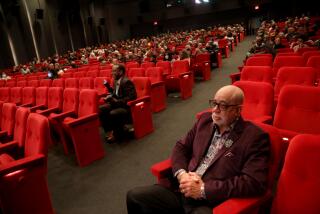R.W. ‘Bob’ Loveless dies at 81; master knife-maker
- Share via
R.W. “Bob” Loveless, who made some of the world’s most coveted sporting cutlery by refining knife design to high art, has died. He was 81.
Loveless died Sept. 2 of lung cancer at his longtime home in Riverside, said his friend Jack Lucarelli.
“He is pretty much the Picasso of the knife world and the father of 20th century knife-making,” said John Denton, an authority on Loveless knives. “His design is what made him famous.”
To many hunters, collectors and fellow bladesmen, Loveless crafted the best handmade knives in the modern world. He was known for fixed-blade knives with unsurpassed workmanship.
“He always said, ‘You want it to look so good that you want to pick it up, and feel so good that you don’t want to put it down,’ ” Denton recalled.
In 1953, Loveless was a seaman on furlough when he tried to buy a blade by master knife-maker Bo Randall at sporting outfitter Abercrombie & Fitch. Told there was a nine-month waiting list, Loveless later said he thought, “It can’t be so hard,” and decided to make his own.
Returning to his ship, he created his first knife from the steel spring of a 1930s Packard automobile, forging the blade on a galley stove.
He sold his first knives for $14 to Abercrombie & Fitch in 1954. When Loveless died, he was selling his knives for $5,000 to $20,000, said Edmund Davidson, a Virginia knife-maker.
Loveless’ most popular blade was a widely imitated drop-point hunting knife, “a modern-day classic which many consider the most attractive knife design of all time,” American Handgunner magazine said in 2006.
He liked to say his knives were aimed at “the working man,” but their beauty and craftsmanship made them highly collectible, Denton said. A major dealer of Loveless knives, Denton once sold one for $50,000 that resold three years later for $150,000.
“A knife is a tool, and I make ‘em to be used,” Loveless groused to The Times in 1981. “It burns me up that most of them wind up in velvet boxes and display cases, priced so high your average deer hunter or cowboy can’t afford ‘em.”
In explaining why people might think his knives were better, he told Sports Illustrated in 1980: “A knife is an extension of your experience. And I’ve had more experiences than most people. There’s more character running in my veins.”
Robert Waldorf Loveless was born Jan. 2, 1929, in Warren, Ohio, and grew up on his grandparents’ Ohio farm.
At 15, he doctored his birth certificate and joined the merchant marine during World War II. The knife fights he witnessed in foreign ports intensified his interest in the weapon, according to Sports Illustrated.
After the war, he joined the Army Air Forces, serving as a control-tower operator on Guam and Iwo Jima.
In the early 1950s, he studied at the Institute of Design in Chicago but left after a few months. One lesson from the Bauhaus movement seemed to stay with him: Form follows function.
Back in Ohio, he attended Kent State but soon dropped out to work on a tanker, where he became familiar with Randall knives.
Once Abercrombie & Fitch started buying his tools, Loveless settled in Delaware before moving to Modesto in 1959. The next year, he moved to Lawndale and worked in machine shops while making knives on the side in his garage.
By the late 1960s, he owned enough machinery to craft knives full time.
He was the first to use the corrosion-resistant steel that became the industry standard, said Davidson, a board member of the Knifemakers’ Guild, an industry organization Loveless helped found in 1970.
In Japan, which Loveless often visited with his Japanese American second wife, he was regarded as a spiritual master of blade craft and was even more revered than he was at home, Denton said.
For decades, Loveless had lived in Riverside, creating knives that were so popular that a five-year wait for one was not uncommon. Since 1982, he had made knives with Jim Merritt, who will continue the Loveless line.
Often outfitted in the shirt and hat of a train engineer, Loveless was a big man with a big personality, a colorful character who wouldn’t sell a fighting knife unless the buyer could prove he was in a hazardous profession.
His survivors include his wife, Yoshiko; three daughters from a first marriage that ended in divorce; and two stepdaughters.
A memorial service is pending.
More to Read
Start your day right
Sign up for Essential California for the L.A. Times biggest news, features and recommendations in your inbox six days a week.
You may occasionally receive promotional content from the Los Angeles Times.







